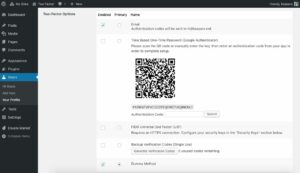Securing WordPress Admin Access
Securing your WordPress admin access is crucial to protecting your website from potential threats.
With WordPress powering over 43% of all websites, it’s a prime target for cybercriminals.
Let’s look into some best practices to enhance your site’s security and reduce vulnerabilities.
Change the Login Page URL
The default WordPress login URL is common knowledge, making it an easy target for bots and hackers.
By changing the login URL, you add an extra layer of security.
Use plugins like WPS Hide Login to customize your login page URL, making it difficult for attackers to find.
Strong Passwords Matter
Creating strong, unique passwords is one of the simplest yet most effective security measures.
Avoid using common passwords or simple combinations. Instead, use a mix of upper and lowercase letters, numbers, and special characters.
For example, a 16-character password with this complexity can take hundreads of years to crack.
Enable Two-Factor Authentication
Two-factor authentication (2FA) adds an extra step to the login process, requiring not just a password but also a verification code sent to your phone or email.
This significantly reduces the chances of unauthorized access, even if your password is compromised.
Plugins like “Two-Factor” can help you set up 2FA on your WordPress site.

Limit Login Attempts
By default, WordPress allows unlimited login attempts, making it vulnerable to brute-force attacks.
Limiting the number of login attempts can prevent automated attacks.
Use plugins like Limit Login Attempts Reloaded to set a cap on login attempts and block IPs after a certain number of failed tries.

Regular Updates and Maintenance
Keeping WordPress, themes, and plugins updated is important for security.
Updates often include patches for known vulnerabilities. Set your WordPress site to update automatically or regularly check for updates manually.
This simple practice can protect your site from many known threats.
KAMINOWEB offers hassle-free WordPress maintenance to ensure your site stays up-to-date and secure.
Use SSL Certificates
An SSL certificate encrypts data transferred between your site and its visitors, protecting sensitive information from being intercepted.
Most hosting providers offer free SSL certificates, and enabling SSL is a straightforward process.
You can also use Let’s Encrypt to obtain a free SSL certificate for your website.
Look for the padlock icon in your browser’s address bar to confirm your site is secure.
Choose Premium Hosting
Investing in premium hosting services can provide enhanced security features.
Premium hosts offer superior performance, better support, and advanced security measures like DDoS protection and automatic backups. This investment can give you peace of mind knowing your site is well-protected.
Consider our managed WordPress hosting service, which offers comprehensive support and top-notch security for your WordPress site.
Disable Login Hints
By default, WordPress provides hints when login credentials are incorrect, which can aid hackers.
Disabling these hints removes this potential vulnerability.
Add the following code to your theme’s functions.php file to disable login hints:
<?php
add_filter( 'login_errors', function() {return 'An error occurred.';} );
Regular WordPress Backups
Regularly backing up your site ensures that you can quickly restore it in case of a security breach.
Use backup plugins to schedule automated WordPress backups and store them securely.
What We Learned
Implementing these best practices can significantly enhance your WordPress site’s security and reduce vulnerabilities.
From changing the login URL to using strong passwords and enabling two-factor authentication, each step adds an extra layer of protection.
Stay proactive and keep your site secure. Happy blogging!
Do you need help with WordPress? Hire us today – we’re here to help and make your WordPress experience smooth and hassle-free!


